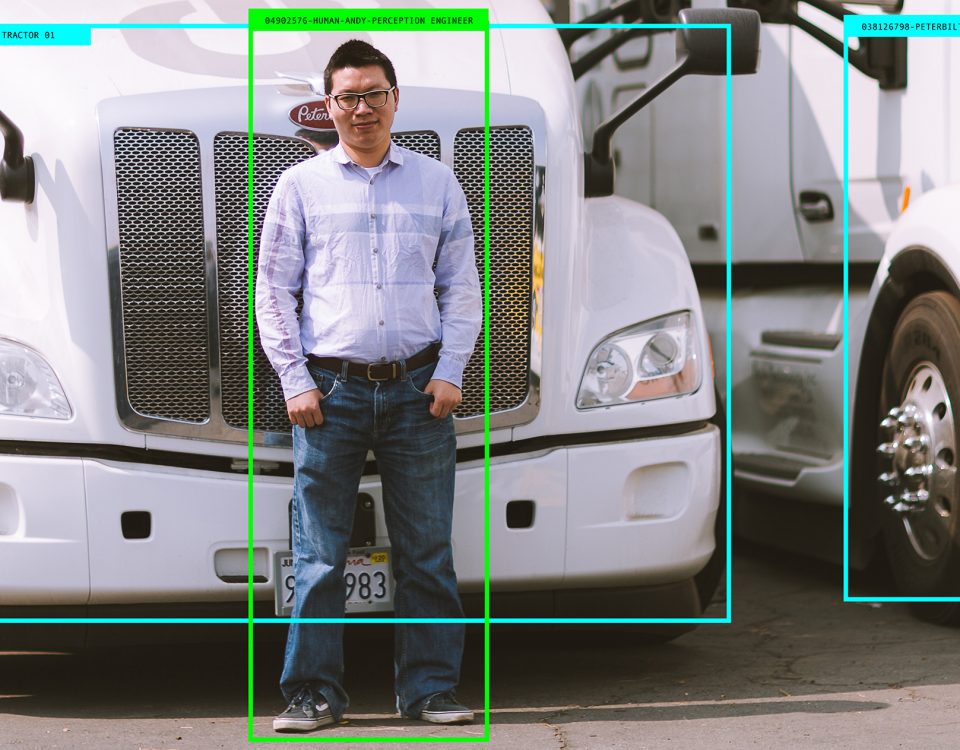
Human-led Truck Automation Uses the World’s Best Perception Sensor
September 28, 2020Human Lives in the Balance: What’s at Stake in the FCC’s Move to Dismantle the Transportation Safety Spectrum
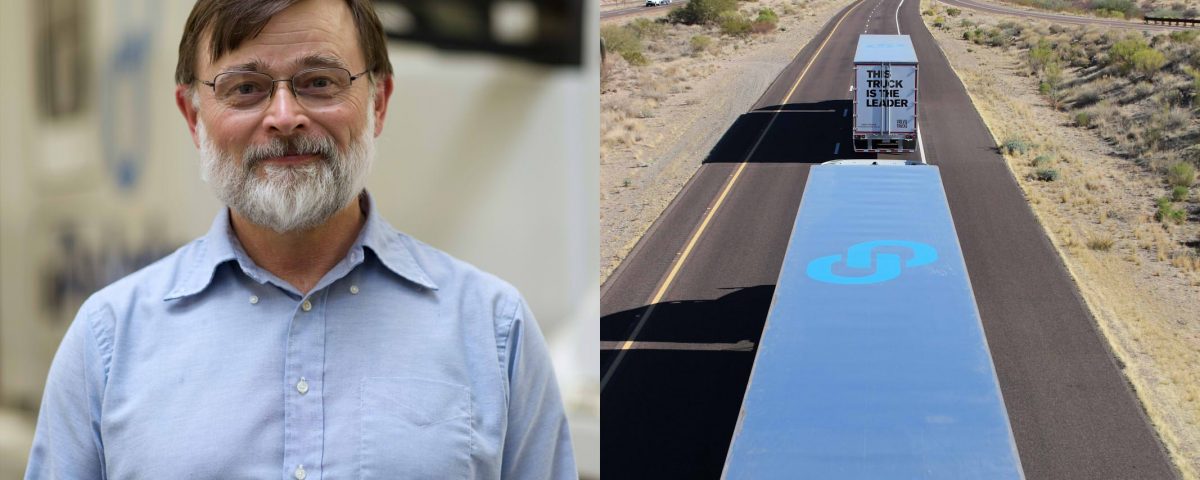
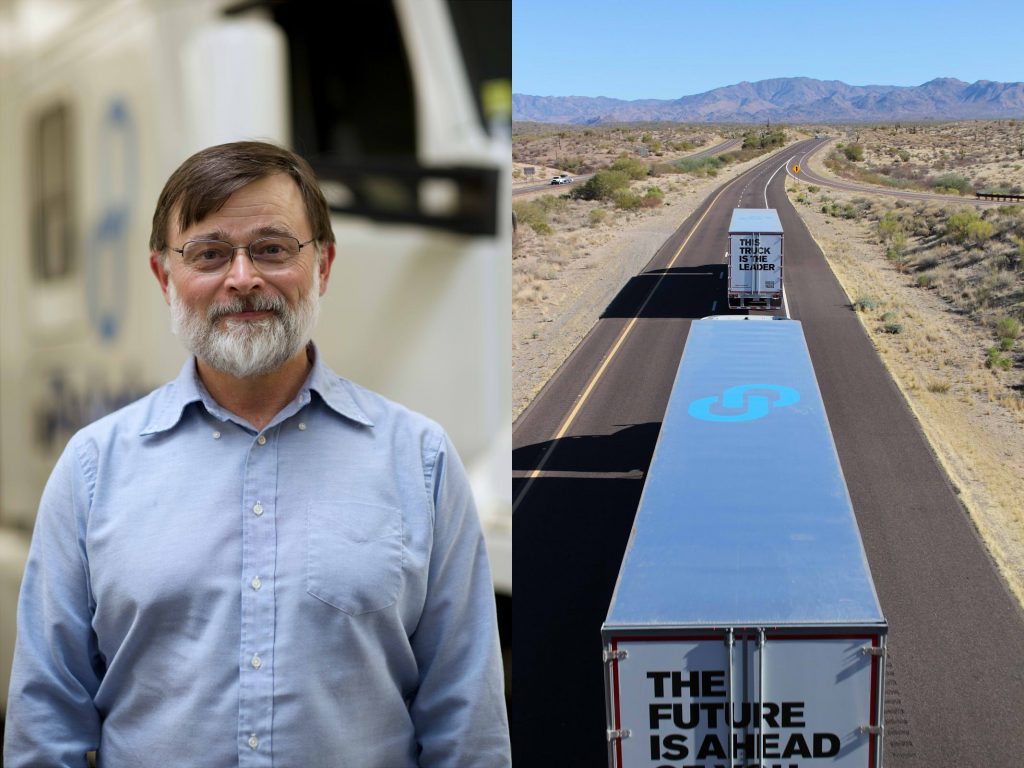
The 5.9 GHz ‘Safety Band’ is a small (75 MHz)—but mighty—slice of the communications spectrum here in the US, which, until now, has been dedicated in service of a national transportation safety infrastructure.
Within this protected wireless spectrum, vehicles can communicate securely with other vehicles in the vicinity, with nearby traffic safety control centers, and with traffic management infrastructure, including stoplights. Today, the full 75 MHz of the transportation safety spectrum provides wireless connectivity for everything from automated toll booths to roadside units broadcasting traveler alerts about construction zones.
But, on November 18, 2020, the FCC approved a ‘First Report and Order’ (FR&O) that critically weakens the 5.9 GHz Vehicle Safety Spectrum and compromises its ability to deliver a safer, more connected transportation future. Under this FR&O, vehicle safety-related operations in most of the 75 MHz band will be curtailed, effectively setting back the clock at least a decade on bringing advanced, connected vehicle (V2X) safety applications to the majority of road users.
Here in the US, where road accidents claim over 100 lives a day, the US DOT considers accelerated deployment of life-saving connected vehicle (V2X) technologies to be a vital part of preventing roadway deaths and injuries. This agency, together with the transportation safety community, has urged the FCC to preserve the 5.9 GHz Safety Band for V2X applications, as it was originally intended.
I’ll admit that, for much of my career as a radio systems engineer, I’ve been on the side of freeing up more spectrum for broadband applications. But now that I’ve been developing and testing on-board, connected vehicle applications, I have come to appreciate the value of having the dedicated 5.9 GHz vehicle communications spectrum for transportation safety applications. So, like many in the transportation safety community, I am deeply concerned about these regulatory changes.
As an engineer with real-world experience bringing automated, connected vehicle technology to the nation’s highways, I want to help set the facts straight about what these regulatory changes will mean to the future of intelligent transportation systems.
V2X Today: 5.9 GHz Spectrum Fuels Advances in Road Safety and Efficiency
Within the federally allocated and protected vehicle safety spectrum, deployment of connected vehicle technology (V2X) has steadily grown.
In the U.S. alone, close to $1.3 billion has already been invested in V2X technologies and infrastructure. Today, 37 states hold V2X licenses, and over 20,000 vehicles have been equipped for use in dozens of connected vehicle deployments to prevent crashes and save lives on the road.
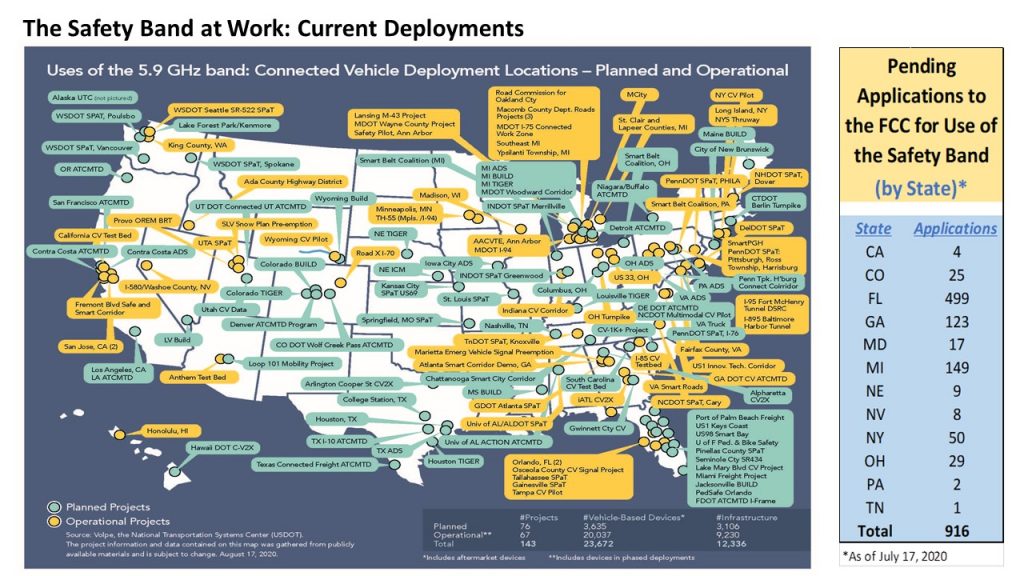
The US Department of Transportation (USDOT) has awarded cooperative agreements collectively worth more than $45 million to pilot sites in New York City, Wyoming, and Tampa to bring connected vehicle technology to consumers, tailored to each region’s unique transportation needs.
In Wyoming, where parts of that state’s busy freight transportation corridor are subject to deadly accidents fueled by fierce winter winds that can blow over a semi-truck, the state DOT (WYDOT) piloted a Traveler Information (TIM) System using connected vehicle technology. Dozens of roadside units (RSUs) and hundreds of on-board vehicle units (OBUs)—including 150 heavy-truck installations—were deployed to broadcast and receive V2X basic safety messages across hundreds of miles of interstate highway. Through this alert system, travelers and WYDOT highway operators receive critical information about adverse road conditions.
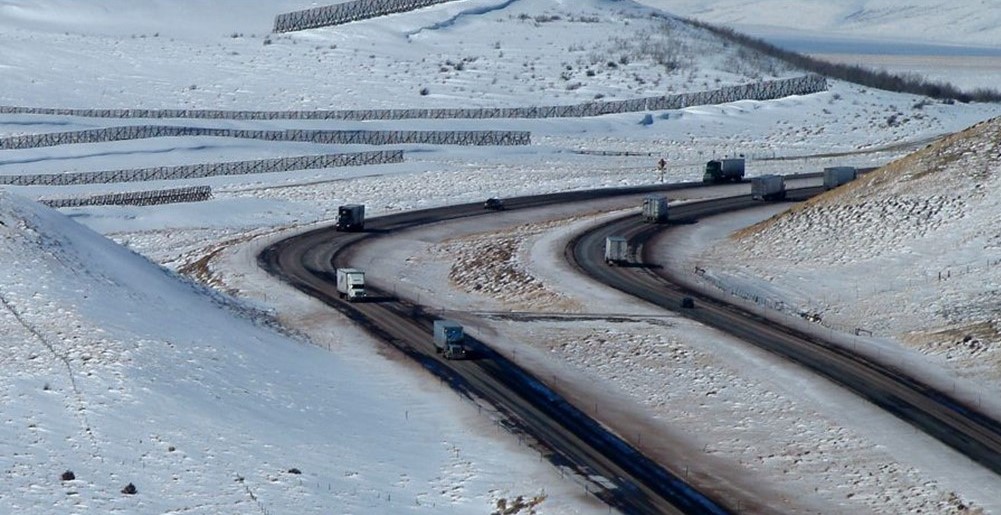
The Wyoming pilot program was so successful that WYDOT expanded the range of the traveler alert system so that WYDOT vehicle and fleet partner vehicles equipped with V2X OBUs can receive safety messages anywhere within the state.
This is just one of many projects to demonstrate the power of V2X messaging and its ability to deliver much-needed improvements in traffic management and road safety. If the 5.9 GHz spectrum remains intact, vehicular communication can be widely deployed, without delay, to create variable speed zones to smooth the flow around a construction zone, deliver timely alerts about road closures and detours, alert drivers traveling in the path of an emergency vehicle—and much more.
Advanced V2X: 5.9 GHz Spectrum Enables Critical Safety Applications
To date, V2X infrastructure has been used largely to support delivery of safety alerts to human drivers and to control traffic signals at intersections. But the game-changing value of the 5.9 GHz Safety Band lies in its ability to support automated, coordinated driving, advanced collision avoidance, and other advanced vehicle safety applications that promise to save many more lives on the road.
Advanced V2V supports fast, direct communication between vehicle control systems, which means these connected vehicles can respond immediately to changes in the driving environment. This machine-to-machine communication means vehicles equipped with advanced V2V can navigate traffic in a cooperative, coordinated fashion. And, in safety-critical driving situations, vehicle control through advanced V2V can save precious seconds—the time normally needed for a driver to perceive and react appropriately—potentially saving lives in the process.
Imagine how much safer the roads would be if the vehicle you’re traveling in could ‘see’ a stalled vehicle in your direction of travel but not in your line of sight. Then imagine cooperative, coordinated acceleration and braking assisting your vehicle and surrounding traffic to navigate smoothly and safely around the stall.
But you don’t need to rely on your imagination, because advanced V2X applications are already on the road today, paving the way for the deployment of these lifesaving technologies in the very near future.
The Future is Here: Advanced V2V On the Road Today
Truck platooning, which has been gaining momentum around the world, is one of the first applications of advanced V2X. Here at Peloton, I’ve helped to design the advanced, wireless vehicle-to-vehicle (V2V) connection that enables a pair of heavy-duty trucks to platoon together and save fuel.
Peloton’s advanced V2V technology allows the rear truck to react immediately to the actions of the front truck. Cooperative, adaptive acceleration and braking between platooning trucks is enabled by a fast, direct radio connection between the vehicle control systems. The 5.9 GHz, interference-free spectrum provides the appropriate environment for these vehicles to operate safely with only 55 feet between them in a platoon.
V2V also enables data sharing between the collision avoidance systems that are standard on Peloton-equipped trucks. These systems share critical situational data with minimal latency.
Like many vehicles today, Peloton-equipped trucks use cameras and additional sensors that detect pedestrians, bicyclists, and encroaching vehicles. Over Peloton’s V2V connection, data is being transferred between the perception systems on a pair of platooning trucks as they travel along, intelligently informing the actions of both trucks. Reliable, accurate long-range perception capability is needed to support heavy-duty truck braking distances. As the level of truck automation increases, enhanced long-range perception capability becomes a more critical requirement. V2V also supports the enhanced perception capabilities used by AutoFollow, Peloton’s Level 4 automated platooning system. The automated follow truck can reliably ‘see’ a greater distance ahead than a standalone driverless truck because, in addition to using its own suite of sensors and perception capabilities, it is receiving perception data from the lead truck. Intelligent operation of the follow truck is enhanced because it is informed by data from the lead truck sensors and the actions of the lead driver, thanks to V2V connectivity.
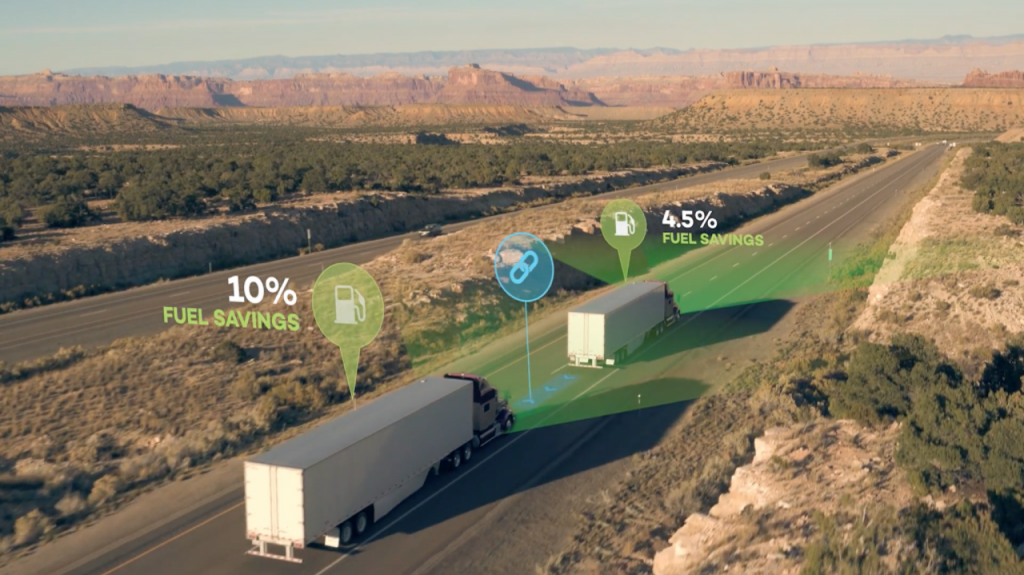
Peloton’s PlatoonPro and AutoFollow systems are among the first applications of advanced V2X and coordinated driving in use on the road today. But, behind this vanguard, a number of game-changing vehicle safety applications are already in development using advanced V2X. Coordinated accident avoidance and cooperative merging around dangerous highway on-ramps and at busy intersections are just a few examples of how vehicle safety can be demonstrably improved for all road users if the 5.9 GHz Safety Band is preserved for advanced V2X applications.
V2X for Safer, Faster Deployment of Autonomous Vehicles
Unlike trucks equipped for platooning or similar advanced connected vehicle applications though, most vehicles today still operate in isolation—like an island on wheels.
This is nowhere more evident than in the world of autonomous vehicles (AVs), where the ‘island on wheels’ approach is one of the factors limiting widespread deployment. Today, AV safety depends on outfitting each vehicle with its own suite of high-cost perception sensors and processors equipped with the massive computing power required to gather and analyze mountains of sensor data.
As the U.S. slowly transitions toward automated driving, society would benefit if automakers and truck manufacturers could use advanced V2V, avoiding the expensive overhead of full AV sensor suites and massive computing power for LIDAR and image perception. Using information modern vehicles already have at hand, advanced V2V can help both regular vehicles and AVs establish a more coordinated driving environment at a modest cost, without the need for additional infrastructure.
Advanced V2X applications will enable automated vehicles to connect with other vehicles and pedestrians in the vicinity, communicating relative location, braking status, and speed even when people and vehicles are out of the AVs line-of-sight. When automated vehicles are connected, communicating, and coordinating with other vehicles, they have more information to use to keep nearby humans and other vehicles out of harm’s way. Even vehicles that are not fully autonomous can realize most of these safety benefits at a significantly reduced cost, as long as there is still room for short-range advanced V2V in the 5.9 GHz spectrum.
Changing Course on V2X: Steering Vehicle Safety in the Wrong Direction
Recent regulatory changes (FR&O) approved by the FCC will have a significant, lasting impact on the safety and efficacy of future connected vehicles. The FCC FR&O severely reduces available V2X spectrum and raises interference risks for the remaining transportation spectrum. It considers only current basic safety alert and signal control applications—completely overlooking future spectrum needs for AVs and for connected vehicles to cooperate to avoid collisions and to reduce carbon emissions.
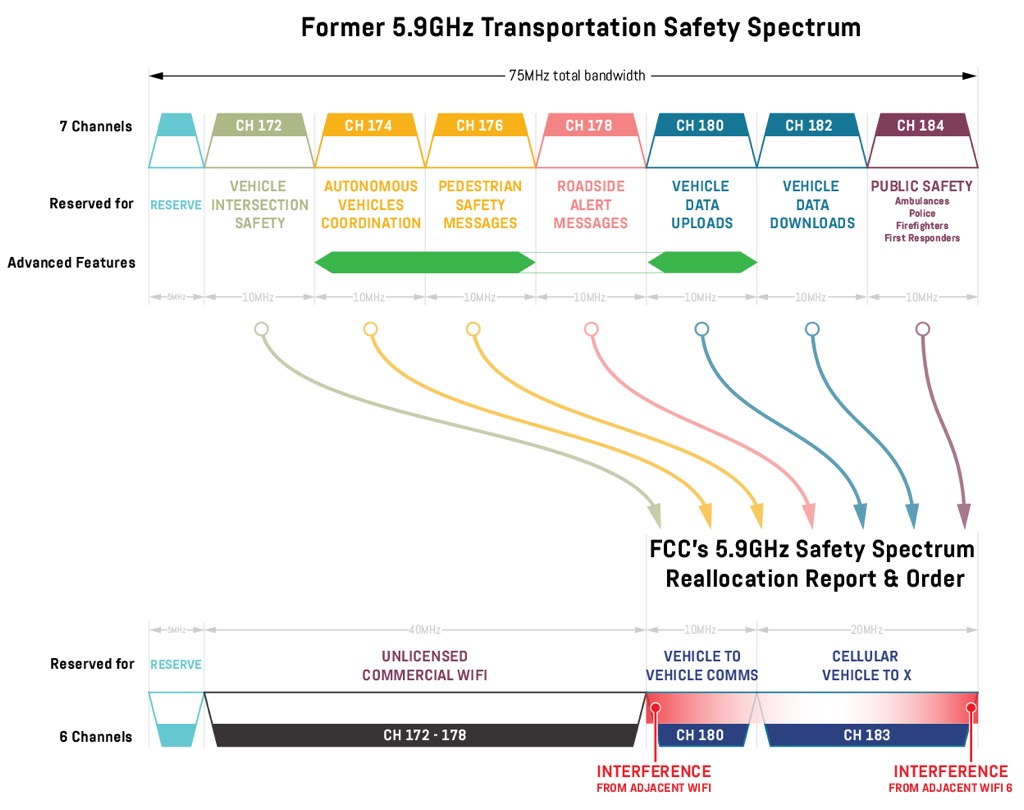
This FR&O takes 60% of the 75 MHz spectrum historically dedicated to vehicle safety and reallocates it to WiFi and other unlicensed ‘U-NII’ services. It’s an outrageous, unjustifiable move that is strongly opposed by the US DOT, all 50 state DOTs, major global automakers, pedestrian safety groups, trucking industry OEMs, and the American Trucking Association (ATA), among others.
The FCC has made great strides in 2020 to allocate more spectrum for consumer WiFi. However, this V2X spectrum being converted to WiFi is less than 4% of the new spectrum recently added for WiFi. Consumers will benefit much more if this spectrum remains available for V2X so that V2X can expand beyond basic safety alerts to enable automatic vehicle-to-vehicle crash avoidance.
Reallocation of the bulk of the 75 MHz Safety Band means walking away from existing infrastructure and a proven, robust communications protocol. Under the FCC’s order, all deployed V2X technologies are required to adopt new V2X hardware and to transition off the spectrum reallocated to WiFi. Many of the safety gains already realized by advanced V2X deployments will be lost.
Forcing advanced V2X applications to move means delaying the delivery of new, lifesaving technologies; we will be lucky to see widespread deployment of coordinated driving and advanced collision avoidance in new vehicles in less than ten years.
The High Cost of Change
Billions of dollars have already been invested in V2X by both the government and the private sector. Regrettably, the FCC’s order requires all V2X and connected vehicle infrastructure to be rebuilt from the ground up. With the loss of the 5.9 GHz spectrum, the bulk of the money invested to date—including hundreds of millions in taxpayer dollars—will be forfeited.
It’s a staggering waste of money that is particularly irresponsible in an era when governments are straining to support other critical public services.
The FCC’s FR&O doesn’t consider costs incurred to replace deployed on-board vehicle safety systems. Even if some of those costs are eventually reimbursed, the USDOT has estimated that the proposal will cost the transportation industry over $500 million just to “rip and replace” current V2X deployments.
Individually licensed V2X infrastructure roadside units (RSUs) would also have to be replaced. On-board V2X units (OBUs) would be recalled and transitioned to different spectrum in the short term, then eventually replaced.
Automakers who have deployed V2X units in private vehicles would be forced to deal with successive recalls: one recall to change the frequency or to disable the units completely until a replacement can be designed and deployed, then another to install replacements.
Save V2X, Save Lives.
It’s exciting and gratifying to be among the pioneers bringing advanced V2V technology to the road. But what’s more meaningful to the team here at Peloton is being part of a critically important, global effort to make road travel safer and more efficient.
Collectively, our work in advanced V2X has helped to establish a strong foundation for safer and more intelligent transportation systems that will benefit all road users.
That’s why Peloton stands united with the bipartisan members of Congress, USDOT and 50 state DOTs, global automakers, ITS America, trucking fleets and trucking industry OEMs, bicycle and pedestrian safety groups, EMS officials, and a host of transportation safety advocates across the US in calling for the preservation of the full 75 MHz of the 5.9 GHz spectrum.
By moving forward with this FR&O, the FCC has chosen to ignore the concerns of transportation safety experts and transportation industry stakeholders. Now, strong public support and immediate congressional action are urgently needed to halt the demise of the Safety Band.
Today, the US is on the cusp of deploying intelligent transportation systems using advanced V2X technology. A growing population and increased demand for last-mile delivery means more vehicles on the road, more congestion, and more accidents, and only lends more urgency to maintaining the full 5.9 GHz spectrum for critical vehicle safety applications.
Coordinated driving, advanced collision avoidance, and connected autonomous vehicle technologies are needed right now, not ten years or more down the line.
Policymakers must prioritize the immediate implementation of these lifesaving technologies rather than dismantle our safety spectrum for a marginal increase in consumer WiFi spectrum.
There is still time to change course. The FCC Chair, with support from Congress, could still give proper consideration to the objections filed by state transportation agencies and industry leaders and lead the FCC to modify the order. Failing that, court challenges are expected, which if successful could alter the course of this order and restore the full 75 MHz of the 5.9 GHz spectrum so that it may continue to be used to protect road users and pedestrians.
We urge policymakers not to settle for what can be deployed today in a small sliver of the dedicated transportation safety spectrum, but to preserve the full band so that we can stay the course with deploying advanced V2X. If we do, we can make the transportation safety vision a reality, we can ease the transition of AVs to our roads by enabling cooperation with today’s cars that only have basic collision avoidance capabilities, and we can save many more lives, far sooner.



